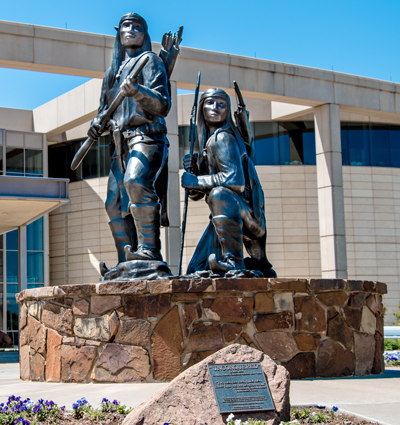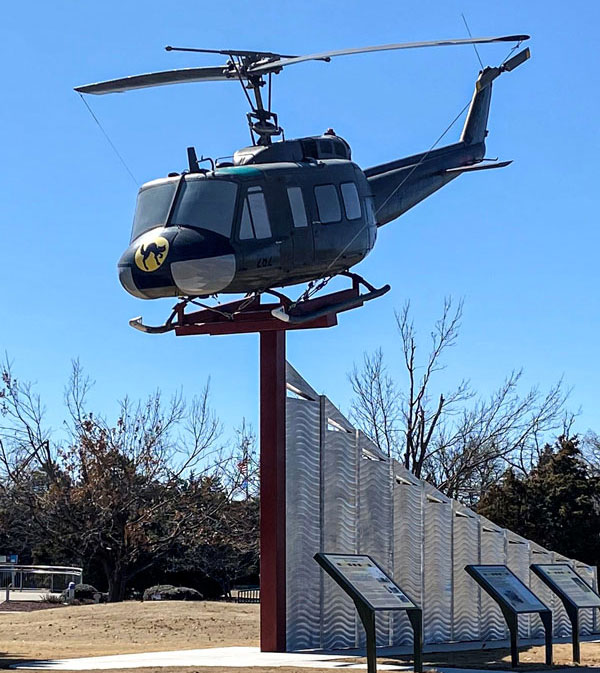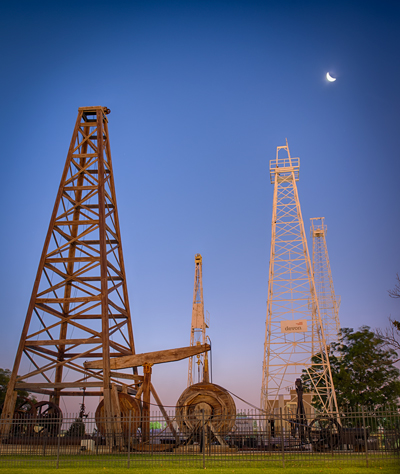
Exterior Exhibits
The Red River Journey and the Meinders Foundation Heritage Gardens
The Oklahoma History Center Red River Journey is a relaxing one-quarter-mile walking tour that replicates the Red River Valley along Oklahoma’s southern boundary. A wonderful exploration of our state’s historical landmarks, the Red River Journey offers visitors a sample of Oklahoma’s diverse terrains as well as our indigenous trees, flowers, and plants.
The Red River is one of the longest rivers in the United States, flowing from the Texas Panhandle along the southern boundary of Oklahoma to the Atchafalaya River in Louisiana.
The Spaniards named it Rio Rojo in recognition of the waters reddish cast. A wild prairie river with soft sandy banks, the river frequently changes its course within its wide stream bed. It has been both an aid and an block to transportation, providing opportunities for navigation (often hazardous), as well as a barrier to be breached for north-south travel. The Red River and its various branches have played a major role in the history of Oklahoma and the southern plains.
The Meinders Foundation Heritage Gardens interpret some of the trees, bushes, flowers, and grasses that are found along the Red River and in other areas of the state. The area also explores geologic features such as the Winding Stair Mountains, Arbuckle Mountains, and Wichita Mountains that strongly influence the people and history of the Southern Plains.
Unconquered

In the final year of his life, Allan Houser would refine and complete his vision for the work Unconquered. Houser utilized the powerful image often seen in historic photographs of two armed Chiricahua warriors, proud and fearless, as they face their enemies. He first created the piece twenty-one inches high in clay, before enlarging the form to nearly ten feet in height for the casting of a monumental bronze. Houser passed away on August 22, 1994. He had completed the full-scale clay model of the sculpture, and the molding and casting of the large version were just beginning. Although he never felt the bronze of the finished casting, his vision lives into posterity. Today, Houser is internationally recognized as a preeminent American Indian artist.
Learn More
Unconquered: Allan Houser and the Legacy of One Apache Family online exhibit
The Encyclopedia of Oklahoma History and Culture
“Allan Houser”
“American Indian Art”
“Fort Sill Apache”
“Outdoor Sculpture”

Monarch at Rest
Monarch at Rest is a larger-than-life bronze sculpture created by renowned artist Harold T. Holden. This graceful sculpture captures a bison, the monarch of the plains, in a restful moment. Monarch at Rest is made possible through the generous sponsorship of John Groendyke.
Primarily known as a cowboy artist, Harold T. Holden captured the West in sculptures and paintings for decades. His works vary in size from large public monuments to a US postage stamp. Notable works include a large sculpture of Will Rogers on horseback installed at the Will Rogers World Airport in Oklahoma City and a kneeling cowboy entitled We Will Remember at the memorial for the 2001 Oklahoma State University basketball plane crash. Several of Holden’s paintings have been displayed at the Oklahoma State Capitol.
Learn More
The Encyclopedia of Oklahoma History and Culture
“Harold T. Holden”
“Bison”
“Outdoor Sculpture”
Civilian Conservation Corps Statue

This sculpture is a tribute to the more than 100,000 Oklahoma men who served in the Civilian Conservation Corps (CCC), safeguarding the natural resources of our nation. Artist John Gooden modeled the work after Reverend Melvin Grant, CCC worker at Camp Wilkerson in Oklahoma, 1940–1. Grant was chosen by the Central Oklahoma CCC Alumni. He was the ninth of sixteen children born to an Oklahoma sharecropper. He grew up in a world of hard work and strong discipline, laboring in the family fields as a plowboy from age fifteen. At 17 he found work and a sense of independence with the CCC. In 1943 Grant joined the Marine Corps and served in World War II. After the war, he worked as a rancher and businessman before following a calling to the ministry.
The CCC was formed in 1933 as a means to employ and train young men left jobless by the Great Depression. Its mission was to install conservation practices, protect infrastructure, and revitalize natural resources. During its years of service, the CCC built thousands of bridges, fishponds, fences, lookout towers, wells and pump houses, and 204 lodges and museums. They developed more than eight hundred state parks, restored 3,980 historic structures, and surveyed and mapped millions of acres of land and hundreds of lakes. The CCC moved and planted 45 million trees and shrubs for landscaping and three billion trees for reforestation.
In Oklahoma, the CCC is credited with the establishment of multiple state parks and numerous recreational areas. CCC workers are responsible for the construction of more than one hundred campgrounds throughout the state, and multiple roads, terraces, shelterbelts, trails, park cabins, and dams
Learn More
The Encyclopedia of Oklahoma History and Culture
“Civilian Conservation Corps”
“New Deal”
“Works Progress Administration”

Tip of the Spear
This UH-1 Iroquois was originally designated as the HU-1A, which is more commonly known as a “Huey.” Typically, Hueys had crews of two officer pilots and two enlisted crew members acting as crew chief and door gunners, who both manned M-60 machine guns.
This helicopter is a shell built of original Huey helicopter parts. It was assembled for the exhibit Welcome Home: Oklahomans and the War in Vietnam by Vietnam veterans and former crew chiefs with the help and sponsorship of Vietnam veteran and helicopter pilot Bob Ford. Stenciled on the side of the Huey are two names: aircraft commander Lieutenant Bob Ford and his crew chief, Crew Engineer Specialist 5th Class Heidi Atanian. The graphic on the nose of the helicopter was the combat insignia for the 282nd Helicopter Assault Company. Ford’s call sign was Black Cat 2-1.
14 Flags Over Oklahoma
Empires, explorers, nations, and people are often known by their symbols. One measure of the last few hundred years of Oklahoma history are the flags of the nations and peoples that lived here, claimed the area, and fought for control of the land, people, and resources. 14 Flags Over Oklahoma identifies and interprets some of the key flags and nations that tell the tale of Oklahoma. This exhibit is made possible by the generous support of OGE Energy Corp.
Royal Standard of Spain
Union Jack of Great Britain
Royal Flag of France
Standard of the Empire of Spain
Standard of France
Second National United States Flag
Third National United States Flag
Flag of the Republic of Mexico
First Flag of the Republic of Texas
Second Flag of the Republic of Texas
Flag of the Choctaw Nation
First National Flag of the Confederacy
First Oklahoma State Flag
Oklahoma State Flag
Devon Energy Oil and Gas Park

The story of oil and gas exploration and discovery is a tale of risk, innovation, fortunes won and lost, spectacular successes, and dramatic challenges. The Devon Energy Oil and Gas Exploration Park at the Oklahoma History Center interprets some of the technology that is part of the history of Oklahoma’s oil industry. Technological innovations in Oklahoma oil fields revolutionized petroleum production worldwide and greatly expanded the industry. This exhibit explores the drilling, production, and transportation phases of the Oklahoma oil and gas industry. Much of the equipment located in the park was donated to the Oklahoma Historical Society in the mid-1960s. Oklahoma oil fields are part of the huge Mid-Continent Oil Region, which stretches from central Texas, across Oklahoma, to eastern Kansas.

